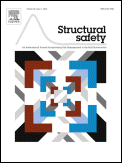
STRUCTURAL SAFETY
metrics 2024
Innovating reliability for resilient structures.
Introduction
STRUCTURAL SAFETY is a premier journal dedicated to advancing the field of engineering with a focus on safety, risk, reliability, and quality in structural analysis and design. Published by Elsevier, this esteemed journal boasts an impressive Impact Factor and ranks in the top quartiles (Q1) of key categories including Building and Construction, Civil and Structural Engineering, and Safety, Risk, Reliability, and Quality. With a significant history spanning from 1982 to 2024, STRUCTURAL SAFETY fosters scholarly exchange among researchers, professionals, and students by publishing innovative and high-quality research articles that contribute to the safety and resilience of engineered structures. The journal operates without open access barriers, ensuring a broad audience can access invaluable insights in the engineering realm. Its distinguished Scopus rankings further underscore its impactful role within the academic community, making it an essential resource for anyone invested in the discipline of structural safety.
Metrics 2024
 1.51
1.51 5.70
5.70 5.90
5.90 114
114Metrics History
Rank 2024
Scopus
IF (Web Of Science)
JCI (Web Of Science)
Quartile History
Similar Journals

Bulletin of Earthquake Engineering
Empowering engineers with cutting-edge insights.The Bulletin of Earthquake Engineering is a premier journal published by Springer, dedicated to the field of earthquake engineering and its related disciplines. Established in 2003, this esteemed journal has evolved into a critical platform for disseminating cutting-edge research in Building and Construction, Civil and Structural Engineering, Geophysics, and Geotechnical Engineering and Engineering Geology, earning a distinguished position in the Q1 quartile across these categories. With an impressive ranking in Scopus, notably a rank of #8 in Earth and Planetary Sciences for Geophysics, the journal addresses urgent challenges in the mitigation of seismic risks and the enhancement of structural resilience. Researchers and practitioners benefit from a wealth of peer-reviewed articles, insights, and methodologies relevant to modern engineering practices aimed at improving safety and sustainability in earthquake-prone regions. The Bulletin of Earthquake Engineering embodies a commitment to advancing knowledge and practice in earthquake resilience, making it an invaluable resource for academics, industry professionals, and rising scholars alike.
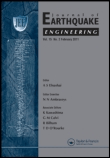
JOURNAL OF EARTHQUAKE ENGINEERING
Leading the way in earthquake resilience and safety.JOURNAL OF EARTHQUAKE ENGINEERING, published by TAYLOR & FRANCIS LTD, stands as a pivotal resource in the fields of Building and Construction, Civil and Structural Engineering, and Geotechnical Engineering. With an impressive Q1 ranking in multiple categories for 2023, this journal is instrumental for researchers, professionals, and students committed to advancing knowledge in earthquake engineering and its practical applications. As a platform that spans the years from 1997 to 2024, it highlights significant contributions to safety, risk, reliability, and quality in engineering practices. While the journal operates on a subscription basis, its highly regarded articles, bolstered by robust Scopus rankings—such as rank #46 in Building and Construction—underscore its credibility and influence in shaping standards and methodologies within the discipline. Promoting innovative and evidence-based approaches, the JOURNAL OF EARTHQUAKE ENGINEERING is essential reading for anyone engaged in the science and technology of earthquake-resistant structures.
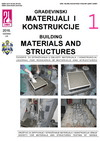
Gradevnski Materijiali I Konstrukcije-Building Materials and Structures
Pioneering sustainable practices in building materials and structures.Gradevnski Materijiali I Konstrukcije - Building Materials and Structures is a premier open-access journal dedicated to advancing the field of construction materials and structural engineering. Published by SOC MATERIALS & STRUCTURES TESTING SERBIA, this journal provides a platform for researchers, professionals, and students to share their innovative findings and developments in building materials. With a commitment to open-access since 2012, it fosters unrestricted availability of research for a wider audience, encouraging collaboration and knowledge dissemination. The journal features a diverse range of topics, including material testing, structural integrity, and sustainable construction practices, making it a vital resource for those engaged in the design and analysis of structural components. By fostering the advancement of research and practice in this crucial sector, Gradevnski Materijiali I Konstrukcije plays an essential role in shaping the future of construction and material science.
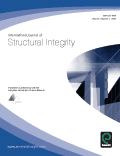
International Journal of Structural Integrity
Championing High-Impact Research in Engineering DisciplinesInternational Journal of Structural Integrity is a premier peer-reviewed academic journal published by EMERALD GROUP PUBLISHING LTD in the United Kingdom. As a valuable resource in the fields of Civil and Structural Engineering, Mechanical Engineering, and Mechanics of Materials, this journal serves to advance knowledge and foster innovation in these critical areas of study. With an impressive impact factor reflected in its 2023 category quartiles, ranking Q2 across multiple engineering disciplines, the journal is recognized for its contributions to research and practical application. Researchers can benefit from its rigorous publishing standards that encompass a wide array of interdisciplinary topics pertaining to structural integrity. Accessing the journal is facilitated for those seeking high-quality research and findings, vital to both academia and industry. Since its inception in 2010 and extending until 2024, the journal continues to attract scholarly articles that push the boundaries of engineering knowledge, making it an essential platform for professionals, students, and researchers seeking to stay at the forefront of structural engineering."
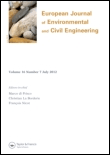
European Journal of Environmental and Civil Engineering
Advancing Sustainable Solutions for a Resilient FutureThe European Journal of Environmental and Civil Engineering, published by Taylor & Francis Ltd, is a prestigious peer-reviewed journal that serves as a vital platform for advancing knowledge in the fields of Civil and Structural Engineering as well as Environmental Engineering. With an impressive impact factor and categorized in the Q2 quartile for both engineering fields, this journal occupies a significant position in the scholarly community. Its focused scope encompasses innovative research, case studies, and practical applications that address contemporary environmental and infrastructural challenges. Researchers, professionals, and students alike benefit from the journal's commitment to high-quality discourse, as evidenced by its Scopus rankings, which place it in the top 30% in Civil and Structural Engineering and the top 40% in Environmental Engineering. Through the publication of cutting-edge studies and a commitment to fostering interdisciplinary dialogue, the European Journal of Environmental and Civil Engineering remains an essential resource for those dedicated to improving our built environment and safeguarding our natural resources.
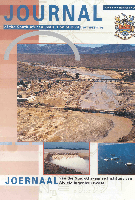
Journal of the South African Institution of Civil Engineering
Elevating standards in civil engineering practices.Journal of the South African Institution of Civil Engineering (ISSN: 1021-2019) is a distinguished open-access publication dedicated to advancing the field of civil engineering in South Africa and beyond. Established by the South African Institution of Civil Engineering (SAICE) and South African Institute of Steel Construction (SAISI), it serves as a critical platform for sharing research, case studies, and industry developments. The journal has been openly accessible since 2015, ensuring broader dissemination of knowledge among researchers, professionals, and students alike. Although it currently holds a Q4 ranking in Civil and Structural Engineering and is positioned within the lower percentiles in Scopus rankings, its commitment to fostering growth in the engineering sector remains strong. Covering various topics from structural design to innovative construction methodologies, the journal invites contributions that push the boundaries of current practices and methodologies. This publication is essential for those invested in sustainable engineering solutions, aiming to collaborate and contribute towards the evolution of civil engineering standards in South Africa.

Structural Integrity and Life-Integritet I Vek Konstrukcija
Fostering Global Dialogue on Engineering Integrity.Structural Integrity and Life - Integritet I Vek Konstrukcija is a prominent open-access journal dedicated to advancing the fields of Civil and Structural Engineering, Mechanics of Materials, and Safety, Risk, Reliability, and Quality. Published by the SOC STRUCTURAL INTEGRITY & LIFE, this journal has been disseminating high-quality research since 2001 from its base in Belgrade, Serbia. The journal's commitment to open access ensures that vital research is freely accessible to a global audience, fostering collaboration and innovation within the academic community. With an impressive categorization in the 2023 quartiles, including Q2 in Metals and Alloys and Q3 in related fields, Structural Integrity and Life stands as a vital resource for researchers, professionals, and students striving to enhance understanding and applications in structural integrity and material performance. The journal invites contributions that address critical issues in the field, pushing the boundaries of knowledge and practical applications, and welcomes both empirical studies and theoretical discussions that can drive forward the next generation of engineering solutions.

Structural Monitoring and Maintenance, An International Journal
Advancing structural safety through innovative research.Structural Monitoring and Maintenance, An International Journal is a prestigious publication dedicated to advancing knowledge in the fields of civil and structural engineering, as well as safety, risk, reliability, and quality assessment. Published by TECHNO-PRESS in South Korea, this journal serves as a vital platform for researchers, professionals, and students interested in the latest methodologies, technologies, and case studies pertaining to structural monitoring, assessment, and maintenance practices. With its current Q3 category ranking in both structural engineering and safety metrics, the journal aims to promote high-quality research that addresses real-world challenges in structural integrity and safety. As the journal converges its scope from 2014 to 2024, it continues to welcome innovative studies that contribute to the development of sustainable and resilient infrastructures worldwide. Despite the absence of an open-access option, the substantial readership is ensured through its indexed positions, currently ranked among the top journals in its field according to Scopus metrics. Engage with groundbreaking research that shapes the future of structural engineering and safety practices by delving into the contributions this journal offers.

Earthquakes and Structures
Fostering interdisciplinary insights for resilient infrastructures.Earthquakes and Structures is a prestigious academic journal published by TECHNO-PRESS, dedicated to the field of Civil and Structural Engineering. Since its inception in 2010, this journal has provided a platform for innovative research and practical applications, addressing critical challenges related to seismic activities and their impact on infrastructure. With an ISSN of 2092-7614 and an E-ISSN of 2092-7622, it is indexed in top databases, reflecting its commitment to quality and relevance, as indicated by its Q3 quartile ranking in 2023. The journal encompasses a wide range of topics, from theoretical investigations to real-world case studies, appealing to researchers, professionals, and students alike. By fostering interdisciplinary collaboration and disseminating cutting-edge findings, Earthquakes and Structures plays an essential role in advancing knowledge and practices in earthquake engineering, enhancing global resilience against seismic threats.
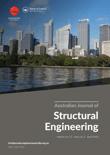
Australian Journal of Structural Engineering
Elevating Standards in Civil and Structural ResearchThe Australian Journal of Structural Engineering (ISSN: 1328-7982, E-ISSN: 2204-2261), published by TAYLOR & FRANCIS AS, serves as a pivotal platform for disseminating high-quality research in the fields of civil and structural engineering, mechanical engineering, and mechanics of materials. With a publications timeline from 2008 to 2024, this journal plays a crucial role in advancing knowledge and practice within its disciplines, boasting Q3 rankings across various categories as of 2023. Although it operates under a subscription model, the journal remains accessible to a diverse audience, including researchers, professionals, and students, seeking to enrich their understanding and engagement with contemporary engineering challenges. The Australian Journal of Structural Engineering is not only a repository of innovative ideas but also a vital resource for fostering collaboration and sparking discussion among scholars and practitioners striving for excellence in engineering design and analysis.